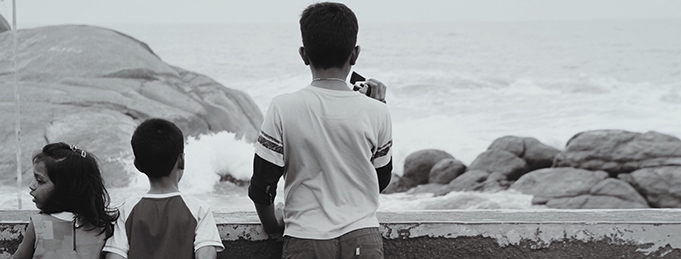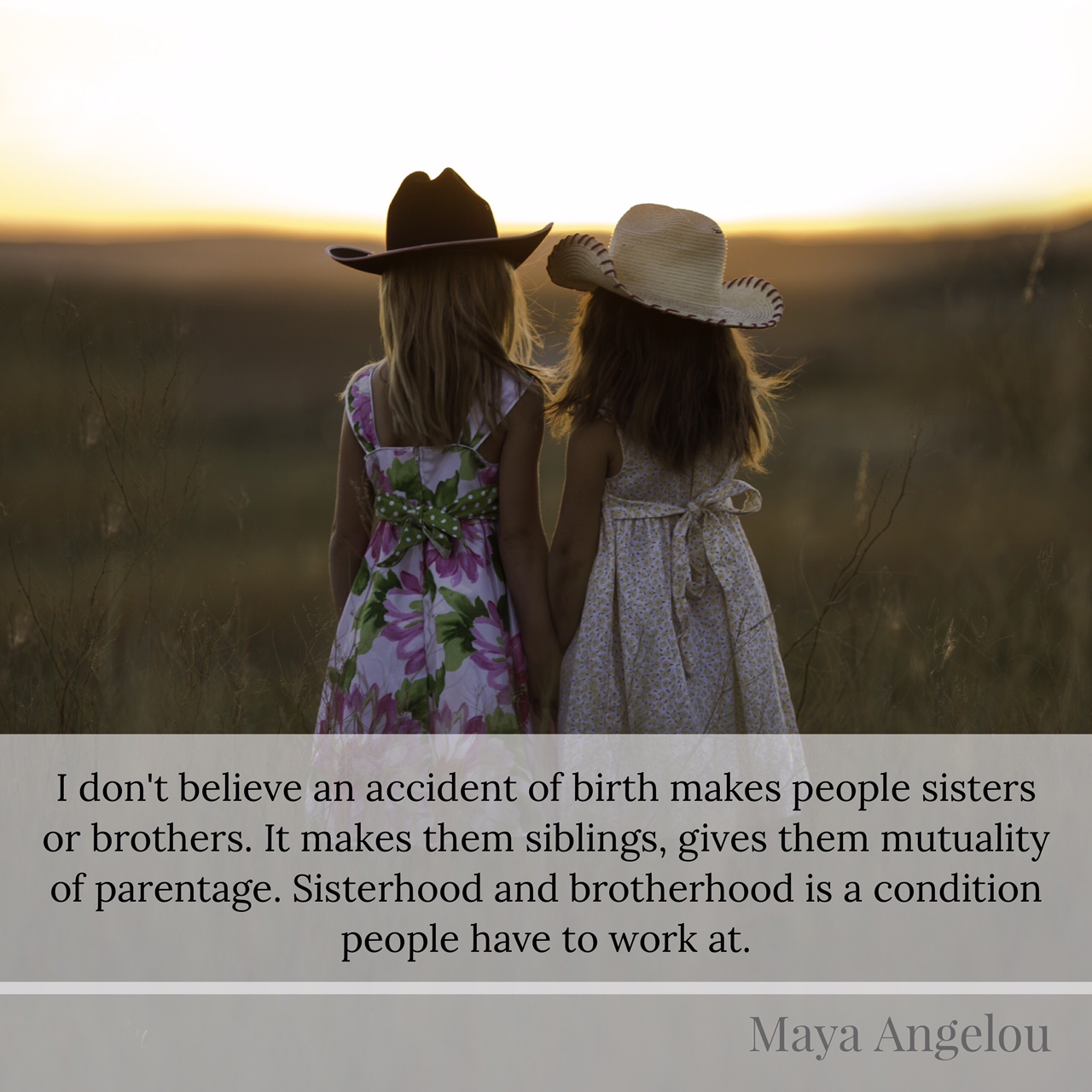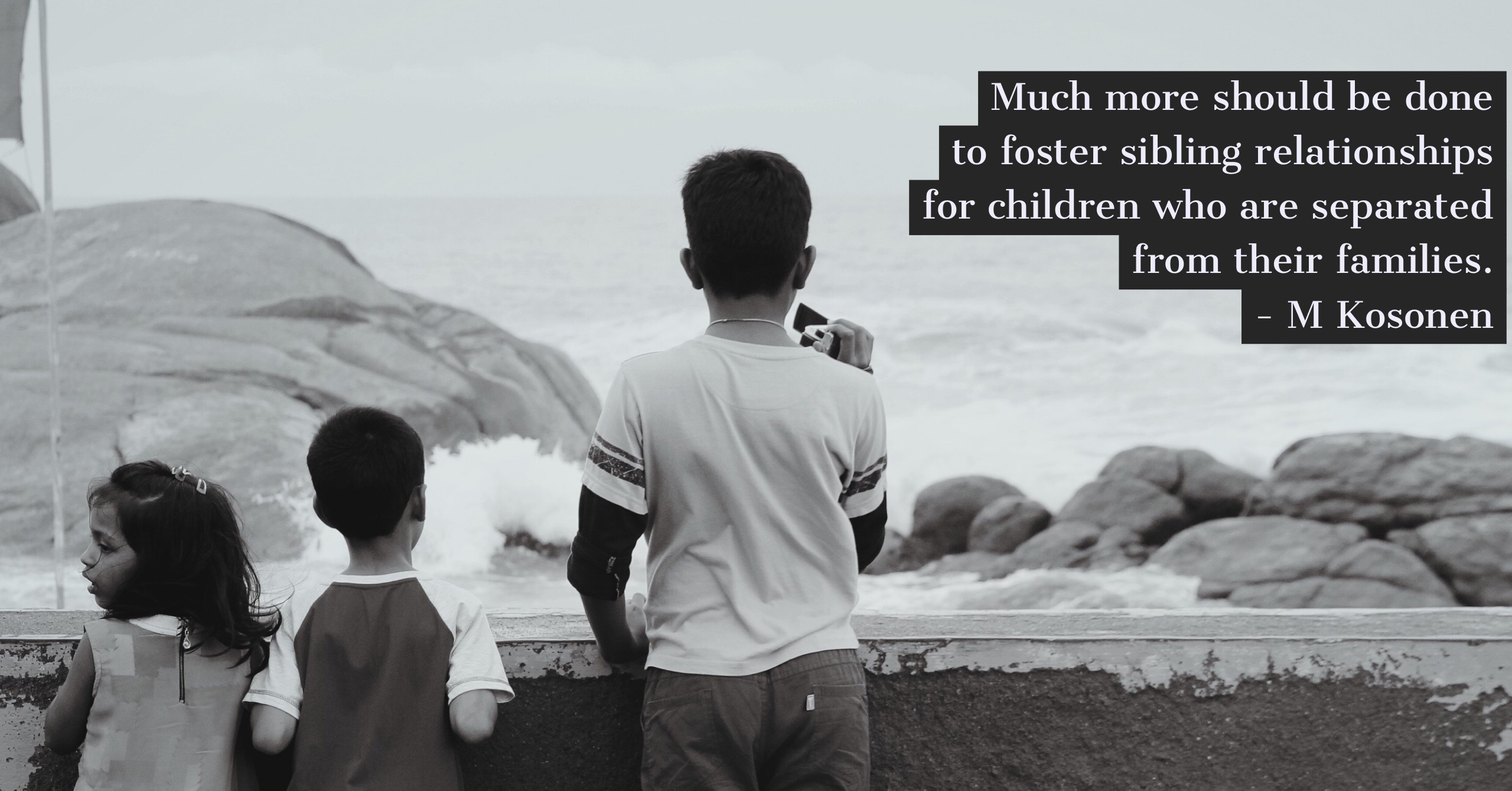
The impact of trauma on sibling relationships

This blog article was authored by Noel MacNamara,
National Manager, Research and Policy at the Australian Childhood Foundation.

A significant aspect of working with children and young people who have been exposed to trauma, abuse, neglect and disrupted attachment and who live in the Out of Home Care (OoHC) systems (this includes Kinship care) around Australia is the impact that these developmental insults have on the capacity of siblings to feel safe and be able to enjoy a relationship with each other.
A growing body of literature supports the critical role of siblings in helping children and young people in OoHC maintain a sense of continuity with family (Create Foundation 2015, (Shlonsky, Elkins, Bellamy, & Ashare, 2005). This is reflected in child protection policy and practice in all States and Territories, which have increasingly emphasised preserving and maintaining sibling relationships of foster children whenever possible. However, In Australia more than a third of children in OoHC are separated from siblings (Leah Bromfield & Alexandra Osborn 2007).
The placement of siblings together has been linked to several positive outcomes, including greater placement stability (Hegar, 2005) and greater likelihood of reunification. Research in the developmental literature indicates that siblings are an important source of emotional support throughout life (Campbell, Connidis & Davies, 1999) and can play a vital role in helping a child adapt to stressful situations (Caya & Liem, 1998. Mark E. Feinberg, Anna R. Solmeyer, Michelle L. Hostetler, Kari-Lyn Sakuma, Damon Jones, and Susan M. McHale 2013).
The placement of siblings into OoHC involves many complexities that are not readily apparent. Of particular importance to those of us working to support children and young people in the OoHC system is that a significant number of these sibling groups have suffered complex trauma within their families of origin. Complex trauma is defined as the exposure to multiple traumatic events, often of an invasive, interpersonal nature, and the wide-ranging, long-term impact of this exposure (Thomas J. Schofield, Rosalyn D. Lee. b, and Melissa T. Merrick, 2013). These events are typically severe and pervasive, such as abuse (physical, emotional) and/or profound neglect. They usually begin early in life and can disrupt a child’s development and their formation of a self. Gardner, Gallagher and Schamess (1998) define trauma in their work with children as a collection of basic traumas, which interfere with and change normal emotional development. Trauma can have devastating effects on a child’s physiology, emotions, ability to think, learn, and concentrate, impulse control, self-image, and relationships with others; including their relationships with their siblings.
Tarren-Sweeney (2008) observed that the range of mental health problems among children in care is exceptional and approaches that of a clinical population. Children in out-of-home care can manifest “complex psychopathology characterised by attachment difficulties, relationship insecurity, sexual behaviour, and trauma related anxiety, conduct problems, defiance, inattention/hyperactivity, and less common problems such as self-injury and food maintenance” (Tarren-Sweeney, M. (2008) pp 345–349.).
Case Example 1
John (name has been changed) was 7 years old and placed with his 5 year old sister in foster care. John’s parents were emotionally and physically abusive towards John. He was often locked out of the home at night and made to sleep on the veranda of the house. John’s parents both misused alcohol and substances and there were many episodes of violence between them that the children witnessed.
Upon placement in foster care John’s behaviour was aggressive, defiant and oppositional. He would regularly physically and verbally attack his sister. He would rampage around the foster carer’s home threatening to harm his sister. At other times, there was a close and warm relationship between the siblings. In many ways they relied on each other to cope with their history of abuse and neglect and the ongoing uncertainty of their situation.
There were many demands to separate the children.
The consequence for children in the OoHC system who experience trauma based relationships with their siblings is significant. They are labelled, separated from one another. They may lose contact with their siblings for life. They experience multiple placement experiences.
What should we do?

“Siblings provide our longest lasting relationships, often extending throughout lifetime. Children growing up apart from their brothers and sisters, lacking contact or knowledge about their siblings may be deprived of family support in adult life. Much more should be done to foster sibling relationships for children who are separated from their families”
Kosonen, M 1996,
Considering the years of study into child abuse, the paucity of information on the impact of trauma by parents and other caregivers on the sibling relationship is quite concerning. The lack of information about the impact is also matched by the lack of research that has been undertaken evaluating specific therapeutic interventions designed to improve sibling relationship quality. The development of work like that of Leavitt and his colleagues is very helpful for those of us in the field.
Leavitt, et al (1998) described a helpful typology of relationships between children who have been traumatised. They describe four types of relationships:
The “Absent” Sibling Relationship
In the “absent” type of sibling relationship, traumatised children have failed to form enough connection to an adult even to seek out other relationships. In such instances, siblings fail to initiate any kind of meaningful attachment with each other. The children behave as though their siblings mean very little to them beyond serving as an interchangeable playmate
The “Adult Lockout” Sibling Relationship
In the “adult lockout” type of sibling relationship, traumatised siblings develop a bond with one another that serves as a substitute for or even a barrier to parent-child attachment. When parents fail to supply appropriate care or when they create an environment of aggression, children may instinctively turn to a sibling as a substitute parent or as a buffer against the aggression.
The “Half and Half” Sibling Relationship
Many siblings have a genuine but extremely problematic sibling process due to their dysfunctional attachments to their caregiver. Much of this type of sibling interaction revolves around siblings using one another to re-enact the difficulties characteristic of the primary relationship
The “Trauma Shield” Sibling Relationship: All for One and One for All
Traumatised siblings living in a violent context may use each other as a “trauma shield.” When siblings develop the trauma shield defences, these defences bring with them the disadvantage of interfering with healthy development but the advantage of giving children a way to manage untenable circumstances.
Case Example 2
John had a “half and Half” relationship with his sister and she used him as a “trauma shield”. John was scapegoated by his parents as the problem child and his sister was forced to collude with this definition of who John was. Despite being in a safe and nurturing placement the children continued to act-out the roles of their dysfunctional relationships with their parents. The children had learned ways to survive in their environment: relating, thinking, feeling, and acting. Both children lacked the capacity for mentalizing, and the components essential for reflective functioning. Mentalizing is defined as having overlapping functions that:
“compel us to interpret (human) actions as caused by intentional sates (beliefs, desires, wishes)…[it] enables humans to infer, attribute and represent the intentional mental states of others-a capacity that can clearly extend to generate representation of one’s own mind ” (Fonagy, Gergely, & Target, 2007, p. 289).
As Siegel (2012) states that mentalization: “may be essential in healthy relationships of many kinds” (p.34). Both children could not mentalize and often misinterpreted the actions and intent of their sibling and the adults in their lives.
Conclusion
It is evident that the nature of the trauma, abuse and neglect that siblings suffer interferes with their individual development. However, it also damages their capacity to benefit from relationships with adults, and growth of healthy sibling connections. There is a gap in literature surrounding trauma treatment and sibling relationships. Trauma is definitely happening to children and in many cases to more than one child within the family. Further research needs to be undertaken to look at outcome results in trauma treatment with siblings. There is a need to develop a wider range of therapeutic interventions that help these children and young people in the following ways:
- Reducing conflict (hostility rivalry/jealousy/ competitiveness, and hostility/aggression)
- Increasing positive connection (warmth and affection)
- Building more adaptive sibling connections (relationship flexibility)
- Helping the sibling group to express shared traumatic content (putting the picture together)
In light of the identified complexities, services seeking to ameliorate the impact of trauma experienced by children could proactively dedicate resource and expertise to the repair and development of the sibling relationship, for children in the Out of Home Care system. As Maya Angelou said “Sisterhood and brotherhood is a condition people have to work at.” We have to find better ways to help these children become brothers and sisters.
References
Bromfield L & Osborn A, ‘Getting the big picture’: A synopsis and critique of Australian out-of-home care research 2007 Australian Institute of Family Studies
Campbell LD, Connidis IA, Davies L. Sibling ties in later life: A social network analysis. Journal of Family Issues. 1999; 20 (1):114–148
Caya ML, Liem JH. The role of sibling support in high-conflict families. American Journal of Orthopsychiatry. 1998; 68 (2):327–333
Create Foundation (2015) Sibling Placement and Contact in Out-of-Home Care.
Fonagy, P., Gergely, G., and Target, M. (2007). The parent-infant dyad and the construction of the subjective self. Journal of Child Psychology and Psychiatry, 48, 288-328.
Gardner, M Gallagher M and Schamess, G (1998) Severely Traumatized Siblings: A Treatment Strategy Clinical Social Work Journal · January 1998 26(1):55-71
Hegar RL. Sibling relationships and separations: Implications for child placement. Social Services Review. 1988; 62:446–467
Kosonen, M ‘Maintaining Sibling Relationships – Neglected Dimension in Child Care Practice’, British Journal of Social Work, 1996, vol. 26, p. 820
Mark E. Feinberg, Ph.D., Anna R. Solmeyer, Ph.D., Michelle L. Hostetler, Ph.D. *,
Kari-Lyn Sakuma, Ph.D., M.P.H., Damon Jones, Ph.D., and Susan M. McHale, Ph.D. 2013 Siblings Are Special: Initial Test of a New Approach for Preventing Youth
Behaviour Problems Journal of Adolescent Health 53 (2013) 166e173
Thomas J. Schofield, Ph.D. a,*, Rosalyn D. Lee, Ph.D. b, and Melissa T. Merrick, Ph.D. Safe, Stable, Nurturing Relationships as a Moderator of Intergenerational
Continuity of Child Maltreatment: A Meta-Analysis 2013 Journal of Adolescent Health 53 (2013) S32eS38
Shlonsky, A., Elkins, J., Bellamy, J., & Ashare, C. J. (2005). Introduction: Siblings in foster care. Children and Youth Services Review, 27, 693– 695.
Tarren-Sweeney, M. (2008). The mental health of children in out-of-home care. Current Opinion in Psychiatry, 21, 345–349
